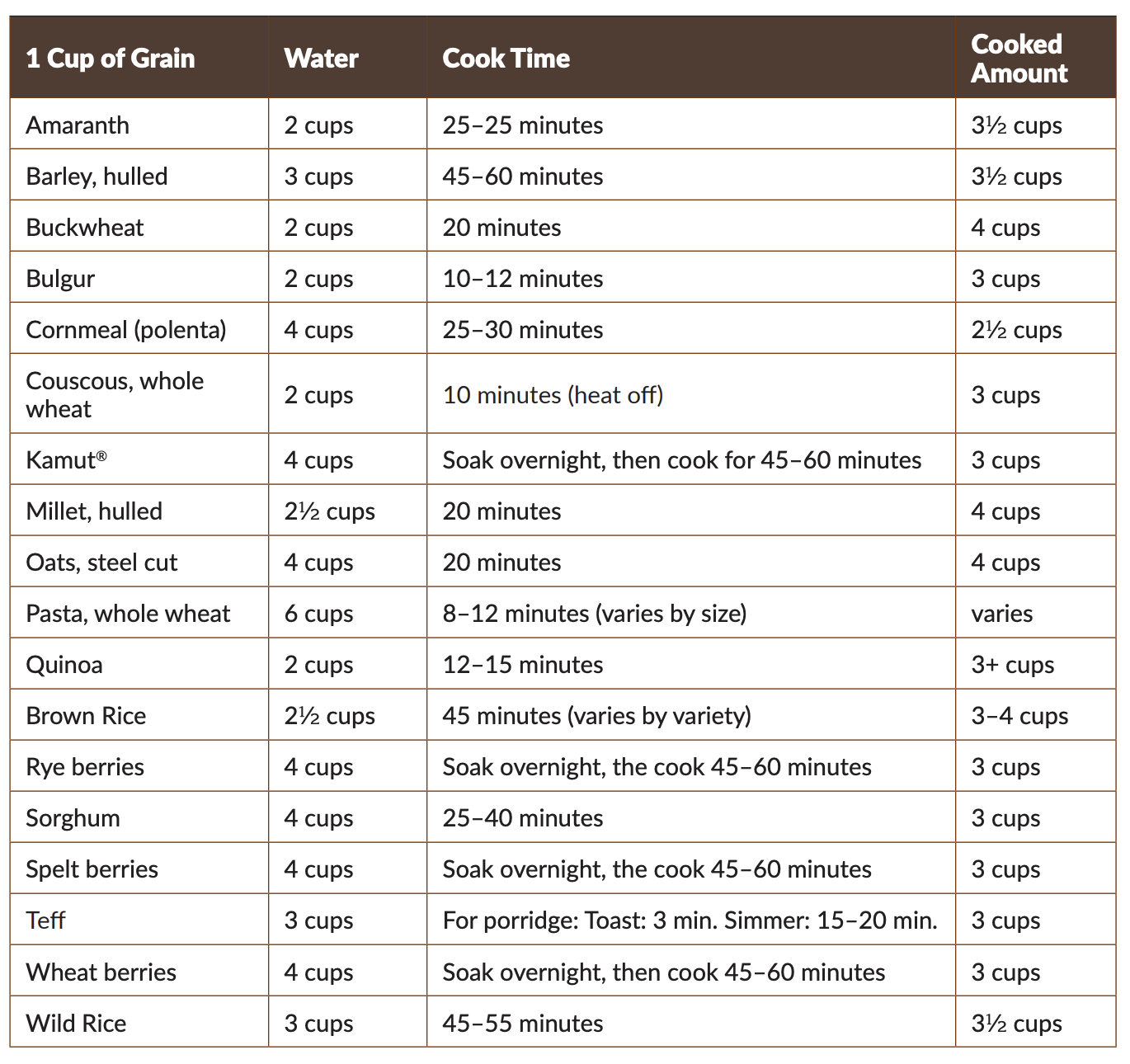Whole Grains have all three parts: bran, germ and endosperm. Refined grains have mostly the endosperm. See What Are Whole Grains? for details. Tips:
- Rice: White rice, white puffed rice, white rolled rice ('poha' / 'chidwa') are refined grains. Brown rice, red rice (unpolished), purple rice, black rice and so on are whole grains.
- Wheat: White flour made from wheat is a refined grain. Semolina ('rawa' / 'poha') is not a whole grain. Wheatberries, cracked wheat ('dalia'), bulgur, and brown-colored whole wheat flour is made from whole grains.
- Barley: Hulled barley is a whole grain; pearled barley is not. See Barley: Hulled vs Pearled. Barley flour could be made from either hulled barley or pearled barley; we should inspect labels to figure out.
If we have, or if we suspect Gluten Intolerance for any reason, we may choose to consume gluten-free grains. Gluten-Free Whole Grains explains:
- Grains with gluten: wheat (including varieties like spelt, kamut, farro and durum; and products like bulgur, semolina), barley, rye, triticale.
- Grains without gluten: Corn, rice, wild rice, oats, sorghum, millets, teff. Pseudo-grains like amaranth, buckwheat and quinoa are also gluten-free.
Gluten free oats: Oats are gluten-free. However, oats may be processed in a facility where grains with gluten were also processed. So they may have trace amounts of gluten. Luckily, several brands of 'gluten free oats' are available in the market.
Ancient Grains has a video by Dr Greger showing one study in which some ancient grains seemed better. However, the overall evidence is weak. Many more studies are needed to establish that ancient grains like kamut, einkorn and emmer are superior.
Arsenic in Rice: Rice is not recommended by Dr Greger, Dr Klaper and many other Whole Food Plant-Based doctors. Why? Because rice has too much arsenic these days! Even if we adopt the best known arsenic reduction cooking technique (boiling in excess water, then draining), cancer risk from arsenic in rice remains too high.
Iron: See Iron Rich Grains. Teff, amaranth and kaniwa stand out. Next come little millet ('samai') and pearl millet ('bajra'). Specific brands of quinoa are iron rich too! For example, Quinta Quinoa from Canada has a whopping 60% iron DV in a mere ¼ cup (170 calories).
Calcium: Teff and amaranth are rich in calcium too! See Calcium Content in Foods. A millet that's exceptionally calcium rich is finger millet (see Millets).
Polyphenols: Sorghum and Kodo Millet are abundant in polyphenols.
Yes! For example,
- Red and black rice is better than brown rice
- Red or black quinoa has more antioxidants than white quinoa.
- Purple and black sorghum are nutritionally richer than regular sorghum.
- In his BROL Recipe with Barley, Rye, Oats and Lentils, Dr Greger mentions that purple barlely is superior to regular barley.
Corn: Frozen sweet corn can be eaten raw.
Oats: Oats may be eaten raw by soaking them in water for sufficient time — see Overnight Rolled Oats Recipes an Overnight Steel Cut Oats recipes.
Buckwheat: We may simply soak buckhweat overnight and eat it in the morning without cooking. See Raw Buckwheat Porridge.
Sprouted Grains: We can sprout so many grains and eat them raw. For example, we can sprout wheatberries, kamut, einkorn, …, amaranth, quinoa, and so on.
In India, we have some grains used for breaking a fast: barnyard millet ('samai ke chawal' or 'samak ke chawal') and buckwheat ('kuttu'). Both are easy to digest. I'm not sure if this property of whole grains is studied in medical literature.
Many people gravitate towards refined grains like white rice or semolina ('sooji' / 'rawa') as 'easy to digest grains'. But these are not whole grains.
Refined grains are attractive because they have longer shelf life. But for optimal nutrition, we must strive to consume whole grains, not refined. How long can we store whole grains in pantry and in freezer? See Storing Whole Grains by Whole Grains Council.
Dr Greger explains that intact whole grains are best! As we pulverize them into finer and finer particles, we increase their glycemic index and we promote overeating. We also reduce the amount of food that we feed our gut bacteria, which affects bowel movements negatively. See these articles for details: Are Oats Healthy (there is a discussion of oat groats vs steel cut oats vs rolled oats vs oat flour) and the collection of articles at Whole Grains Hiearchy.
For cooked breakfast, my favorite grains are amaranth, teff and oats. Next come buckwheat, quinoa, spelt and kaniwa. For raw breakfast, my favorite grains are einkorn and kamut — both sprout well and taste great! I also like overnight soaked oats for a raw breakfast. And I love sweet corn in salads. And then come all the other grains like rye, wheat, barley, pearl millet, other millets, and so on.
Millets are awesome! However, in my experience, they go well with savory recipes, not sweet breakfast recipes. Since I have grains only for breakfast (and rarely for lunch and dinner), millets didn't come into my food system in a big way. If I were to pick the best millets, I would go for the two iron rich millets: little millet and pearl millet (in its whole form, not polished). And I would pick finger millet for calcium. And I would pick kodo millet for phenols. And I would pick barnyard millet for its easy digestibility (it's used for fasting in India).
I avoid rice as it has too much arsenic. And I never buy flours.

 Instagram
Instagram YouTube
YouTube